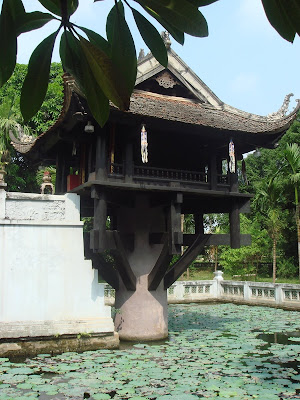The One Pillar Pagoda was built by Emperor Ly Thai Tong, who ruled from 1028 to 1054. According to the court records, Ly Thai Tong was childless and dreamt that he met the bodhisattva Avalokiteshvara, who handed him a baby son while seated on a lotus flower. Ly Thai Tong then married a peasant girl that he had met and she bore him a son. The emperor constructed the temple in gratitude for this in 1049, having been told by a monk named Thiền Tuệ to build the temple, by erecting a pillar in the middle of a lotus pond, similar to the one he saw in the dream.
The Pagoda was located in what was then the Tây Cấm Garden in Thạch Bảo, Vĩnh Thuận district in the capital Thăng Long (now known as Hanoi). Before the pagoda was opened, prayers were held for the longevity of the monarc.
The temple was renovated in 1105 by Emperor Lý Nhân Tông and a bell was cast and an installation was attempted in 1109. However, the bell, which was regarded as one of the four major capital works of Vietnam at the time, was much too large and heavy, and could not be installed. Since it could not be tolled while left on the ground, it was moved into the countryside and deposited in farmland adjacent to Nhất Trụ Temple. This land was widely inhabited by turtles, so the bell came to be known as Quy Điền chung, which means Bell of the Turtle Farmland.
At the start of the 15th century, Vietnam was invaded and occupied by the Ming Dynasty. In 1426, the future Emperor Le Loi attacked and dispersed the Chinese forces, and while the Ming were in retreat and low on weapons, their commanding general ordered that the bell be smelted, so that the copper could be used for manufacturing weaponry.
The temple was initially built of wood on a single stone pillar 1.25 m in diameter, and it was designed to resemble a lotus blossom, the Buddhist symbol of purity. In 1954, the French Colonial forces burned the pagoda before withdrawing from Vietnam after the First Indochina War and the pagoda was then rebuilt in 1955.

